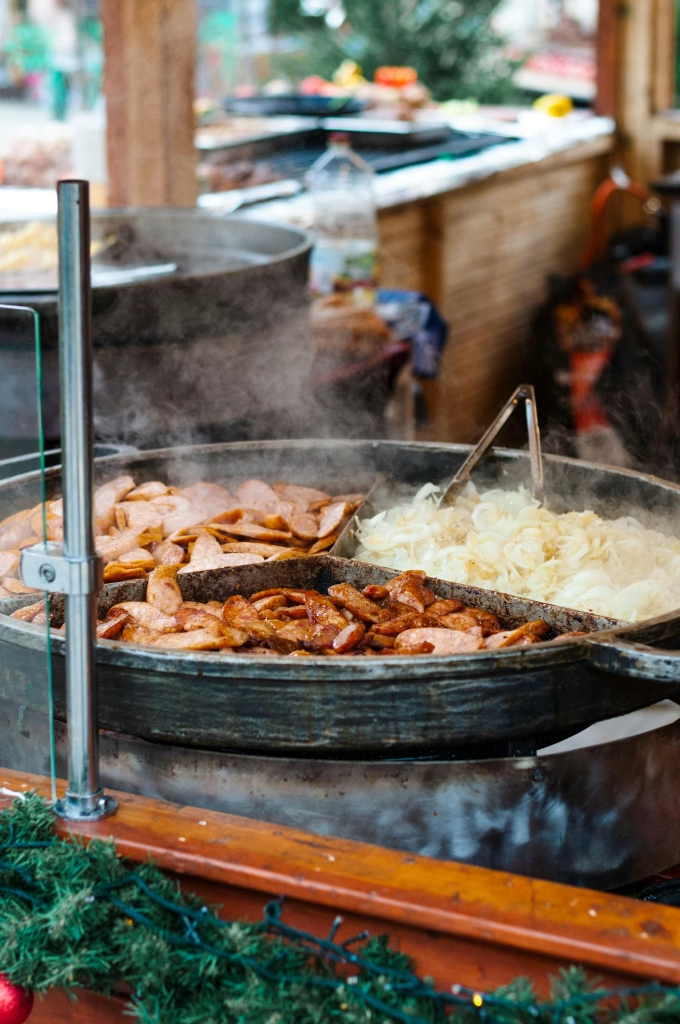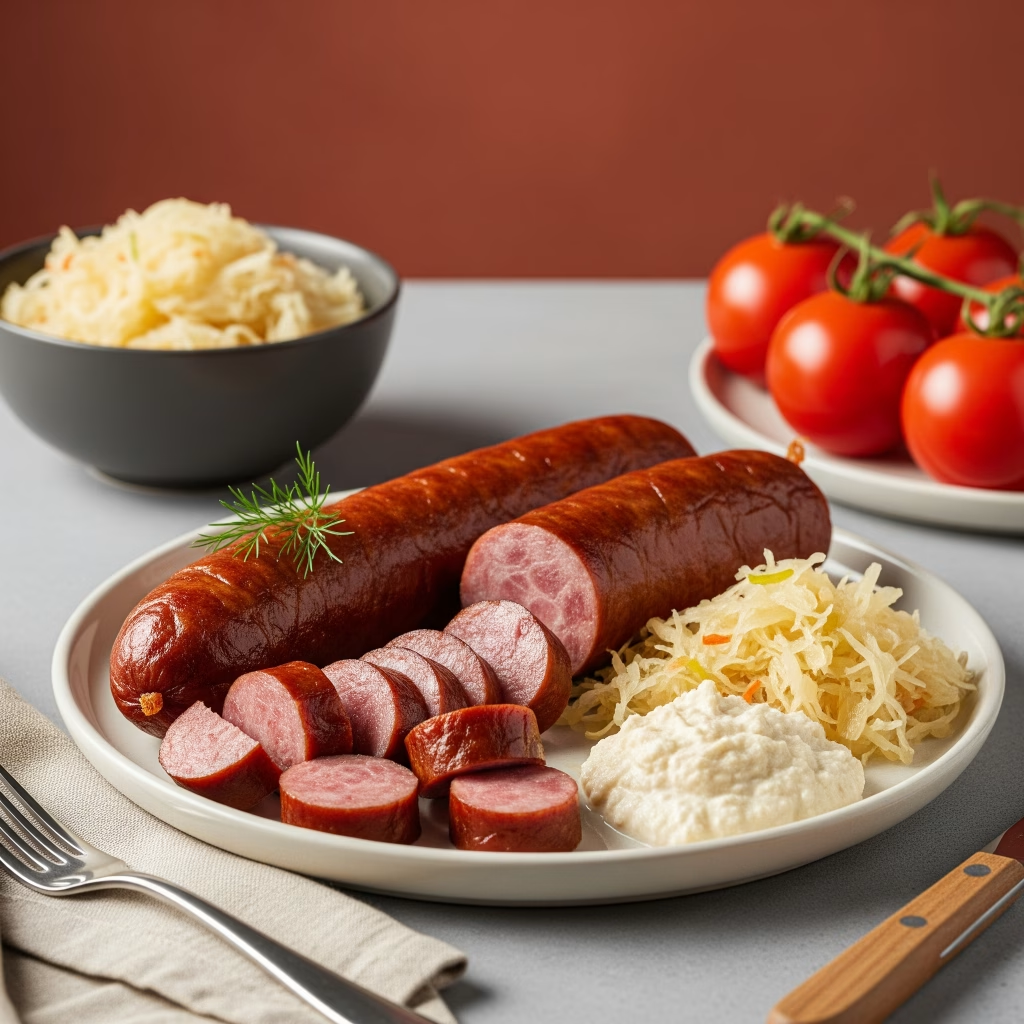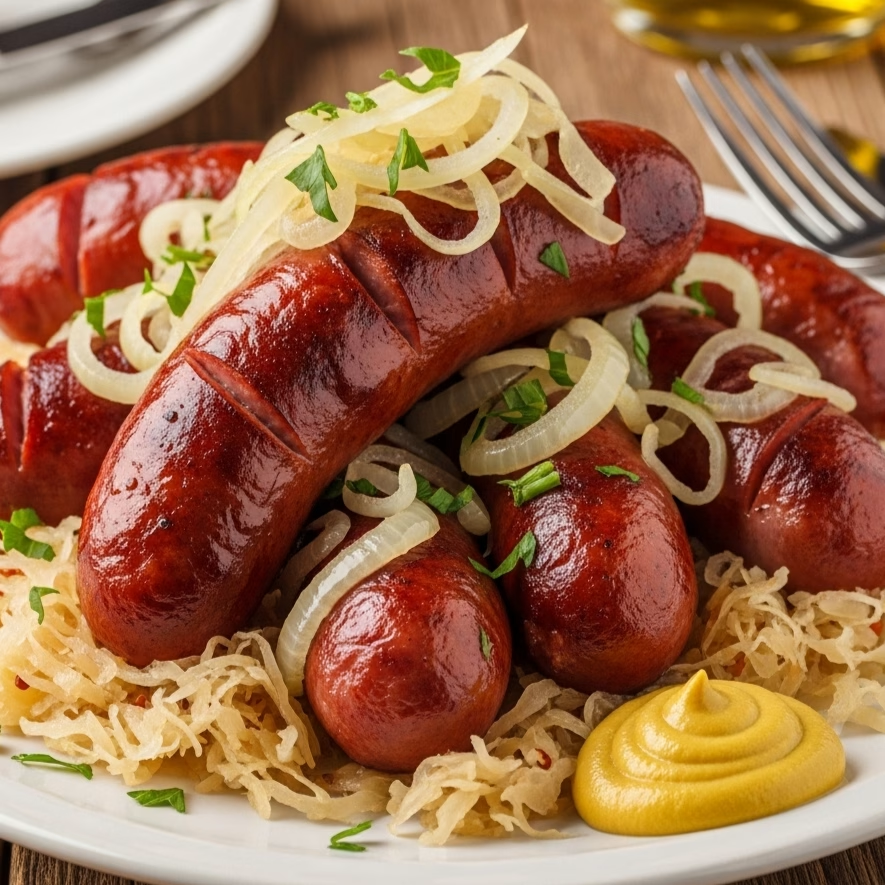Polish Kielbasa is more than just a sausage, it’s a symbol of Polish culinary heritage.
Whether grilled, fried, boiled, or smoked, this sausage brings hearty comfort to the table and connects generations through its bold, garlicky flavor and smoky aroma.
In this comprehensive guide, we’ll dive deep into making authentic Polish Kielbasa from scratch, explore its rich history, share variations, health alternatives, and answer your most common questions.
Table of Contents
Ingredients for Polish Kielbasa
This recipe makes about 2.5 kilograms (5.5 pounds) of sausage, enough for 10-12 generous servings.
Meat and Fat:
- 1.5 kg (3.3 lbs) pork shoulder (well-marbled)
- 0.5 kg (1.1 lbs) pork belly (for fat content)
- 0.5 kg (1.1 lbs) beef chuck or veal (optional, for a firmer texture)
Seasonings and Additions:
- 6 cloves garlic (minced or pressed)
- 25 g (1.5 tbsp) salt (non-iodized, such as kosher or curing salt)
- 2 tsp black pepper (coarsely ground)
- 1 tsp marjoram (optional but traditional)
- 1/2 tsp sugar (balances flavor)
- 150 ml (2/3 cup) cold water or crushed ice (for mixing)
Casings:
- 3–4 meters (10–13 feet) of natural pork casings (soaked, rinsed, and flushed)
Optional for Smoking:
- Wood chips (apple, hickory, or cherry preferred)
- Smoker (for cold or hot smoking)
Step-by-Step Instructions to Make Polish Kielbasa
Step 1: Prepare the Meat
- Trim the meat of any sinew or gristle but leave the fat intact.
- Cube the pork shoulder, pork belly, and beef into 1-inch chunks.
- Chill the meat in the freezer for 30 minutes to make grinding easier.
Step 2: Grind the Meat
- Use a meat grinder with a coarse grinding plate (about 6–8mm).
- Grind all the meat and fat once. For a finer texture, you can regrind half of the batch using a finer plate (optional).
- Return the ground meat to the fridge to keep cold.
Step 3: Season the Meat
- Add garlic, salt, pepper, marjoram, sugar, and cold water to the meat.
- Mix thoroughly by hand or with a stand mixer paddle for 5–10 minutes until the mixture is sticky and slightly glossy—this activates the myosin protein for proper binding.
Step 4: Prepare the Casings
- Soak the casings in warm water for at least 30 minutes.
- Rinse the inside of each casing by running water through it.
- Keep casings submerged in water until ready to use.
Step 5: Stuff the Sausage
- Fit your sausage stuffer with a medium stuffing tube.
- Slide a length of casing onto the tube.
- Tie a knot at the end of the casing.
- Fill the sausage carefully, avoiding air pockets. Don’t overstuff or the casing may burst.
- Twist into 12-inch links or leave in one long coil.
- Prick air bubbles with a sterile pin.
Step 6: Dry the Sausages
- Hang the kielbasa in a cool, well-ventilated space or refrigerator uncovered for 12–24 hours. This helps develop the outer skin and flavor.
Step 7: Smoke the Kielbasa (Optional but Traditional)
- Cold Smoke: Smoke at 20–30°C (68–86°F) for 6–8 hours using fruitwood.
- Hot Smoke: Smoke at 75°C (167°F) until the internal temperature reaches 68–71°C (155–160°F).
Step 8: Cook or Store
- Cook fresh kielbasa by boiling, grilling, or frying.
- Store smoked kielbasa in the fridge for up to 2 weeks or freeze for up to 3 months.

Serving Suggestions for Polish Kielbasa
- Grilled with Mustard & Sauerkraut: Classic combo with tangy and savory elements.
- With Potatoes: Serve with mashed, roasted, or fried potatoes for a filling meal.
- In Soups: Add slices to Polish dishes like żurek (sour rye soup) or kapuśniak (cabbage soup).
- Sautéed with Onions and Peppers: A quick skillet meal.
- As a Breakfast Side: Sliced and pan-fried next to eggs and toast.
Tips for Perfect Polish Kielbasa
- Use Cold Ingredients: Keep meat and fat cold throughout the process to prevent smearing and ensure good texture.
- Don’t Skip Mixing: Proper mixing is crucial for binding the sausage.
- Natural Casings = Best Flavor: They also offer that satisfying snap.
- Smoke Slowly: Avoid high heat that cooks the sausage before it absorbs smoke.
- Dry Before Smoking: A dry surface helps smoke adhere better and prevents casing shrinkage.
Healthier Alternatives
- Use Leaner Cuts: Replace pork belly with lean pork loin or turkey thigh.
- Reduce Salt: Cut salt slightly and use herbs to enhance flavor.
- Bake Instead of Fry: Oven-roasting reduces added oil.
- Skip Smoking: Fresh kielbasa without smoke still delivers flavor.
- Low-Fat Casings: Use collagen casings if you’re avoiding pork or fat.
Creative Variations of Polish Kielbasa
- Spicy Kielbasa: Add red pepper flakes or chili powder.
- Herbed Kielbasa: Mix in thyme, rosemary, or dill for aromatic flair.
- Cheese-Stuffed: Fold in small cubes of smoked gouda or cheddar.
- Wild Game Version: Use venison or boar instead of pork.
- Beer-Soaked Kielbasa: Add dark lager to the mix or poach in beer for flavor.
Common Mistakes to Avoid
- Overstuffing the Casings: Leads to burst sausages.
- Grinding Warm Meat: Causes fat smearing and poor texture.
- Under-mixing: Sausages will be crumbly instead of cohesive.
- Skipping the Resting Time: Reduces flavor development and structure.
- Using Too Much Salt or Garlic: Overpowers the meat flavor.
- Wrong Casings: Artificial ones lack the classic snap and taste.
- Not Checking Temperature While Smoking: Can result in unsafe sausage.
- Freezing Before Resting: Freeze only after full drying and optional smoking.
- Air Bubbles: Leads to uneven cooking or bacterial growth.
- Ignoring Hygiene: Always sterilize tools and wash hands during prep.
History of Polish Kielbasa
The word kielbasa simply means “sausage” in Polish, but its legacy runs far deeper than the definition implies. With roots dating back over 500 years, kielbasa has long been a staple of Polish cuisine, celebrated for its robust flavor and versatility. Traditionally made with pork, though occasionally beef or veal, it’s seasoned with garlic, marjoram, pepper, and then often smoked for preservation and taste. Rural families in Poland would produce their own kielbasa in winter months, using it to sustain them through long, harsh winters.

In Polish culture, kielbasa isn’t just food, it’s ceremonial. It graces Easter baskets blessed in church (święconka), anchors wedding feasts, and fuels soldiers during national conflicts. Every region of Poland has its variation, from the garlic-forward Kielbasa Wiejska (farmhouse sausage) to Kielbasa Krakowska, known for its firm texture and dense smoke. The art of sausage-making was passed down generationally, often without written recipes—just hands, senses, and memory.
When Polish immigrants spread across the globe, especially to the United States and Canada, they brought kielbasa with them. In cities like Chicago and Buffalo, kielbasa evolved, adopting local influences. Yet, it retained its essence—a bridge to home, culture, and comfort. Today, whether homemade or store-bought, Polish Kielbasa remains a savory ambassador of Polish tradition.
FAQs About Polish Kielbasa
1. What is Polish Kielbasa made of?
Primarily pork, but sometimes beef or veal is added. Seasonings usually include garlic, pepper, salt, and marjoram.
2. Is Polish Kielbasa always smoked?
Not always. Some versions are fresh and cooked by boiling or frying, while others are cold- or hot-smoked.
3. How is it different from regular sausage?
Polish Kielbasa often has a coarser grind, traditional garlic-based seasoning, and natural casings, offering a unique texture and flavor.
4. Can I make it without a sausage stuffer?
Yes, but it’s harder. You can hand-stuff casings or shape it into patties for a simplified version.
5. How long does homemade kielbasa last?
Fresh: 3–5 days refrigerated. Smoked: up to 2 weeks refrigerated or 3 months frozen.
6. Can I make it without pork?
Yes, you can use beef, turkey, or chicken, though flavor and texture will differ slightly.
7. Do I have to use casings?
No, but casings give the sausage structure and snap. You can make skinless sausages, though they may dry out faster.
8. How do I reheat smoked kielbasa?
Simmer gently in water, pan-fry, or grill on low heat. Avoid microwaving to preserve texture.
9. Can I eat it raw?
Only if it’s fully cooked during the smoking process. Most kielbasa is sold pre-cooked, but always check the label or internal temperature.
10. What’s the best way to serve kielbasa at a party?
Slice into bite-sized pieces, grill or sauté, and serve with mustard, horseradish, and pickles on a platter.
Authentic Polish Kielbasa is a testament to traditional craftsmanship, bold flavor, and cultural pride. Making it from scratch is a rewarding experience that brings the Old World right into your kitchen. Whether you’re savoring it freshly grilled with mustard or adding it to a hearty Polish stew, kielbasa offers rustic comfort with every bite. With proper ingredients, care in preparation, and respect for its roots, you can bring the rich taste of Poland to your table, no passport required.


